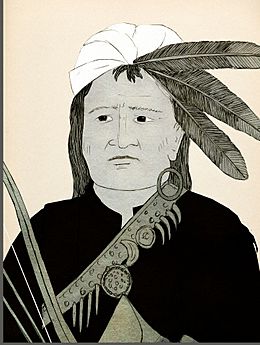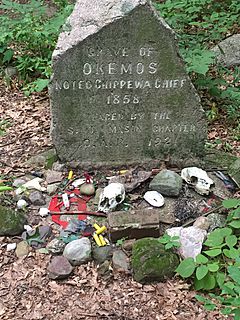John Okemos facts for kids
John Okemos (also known as Chief Okemos) was an important Ojibwe (Chippewa) chief. He was born around 1775 and passed away in 1858. His Ojibwe name was ogimaans, which means "Little Chief." "John" was a name he adopted later in life. Chief Okemos played a role in Tecumseh's War and was one of the leaders who signed the Treaty of Saginaw.
Contents
Early Life of Chief Okemos
We don't know the exact date or place where Okemos was born. Many believe he was born in Shiawassee County, Michigan, possibly near the Knaggs Bridge area. He was likely born in the mid-1770s.
In 1856, Chief Okemos said, "I was born in Michigan, near Pontiac, Michigan, on an island in a lake." He also said, "I was 30 years old when I left the place I was born." One possible island he might have been talking about is Apple Island in Orchard Lake, Michigan.
Chief Okemos's Family
Okemos shared that his mother's father was an Ojibwe chief named Min-e-to-gob-o-way. His uncle was an Odawa chief named Kob-e-ko-no-ka.
Later in his life, Okemos was not wealthy. He traveled to Sarnia, Canada, to ask the British government for a military pension. Sadly, his wife passed away during this trip and was buried there.
It is believed that Okemos was the father of A-da-wah-qua Ogimas. She was one of the wives of Chief Cobmoosa of the Flat River Band. We know he had at least three other children: Jim, John, and Mary. Mary's native name was Mekchis Quahwis Okemos.
Serving with the British Army
The first official record of Okemos is from 1796. At that time, Okemos and 16 other men joined the British armed forces. They served as scouts.
Okemos fought in the Battle of Lower Sandusky on August 2, 1813. This battle happened in northern Ohio during the War of 1812. Even though the British lost the battle, Okemos gained a lot of respect for his bravery. This increased his standing among the Ojibwe people. During the battle, Okemos was cut by a saber. This left a five-inch scar on his forehead that he carried for the rest of his life. It became a unique mark that helped people recognize him.
Later Years and Legacy
The Treaty of Saginaw
In 1819, Chief Okemos represented the Ojibwe people at the Treaty of Saginaw. This treaty involved several Native American tribes. The Ojibwe lost the most land in this agreement. Other tribes affected included the Odawa and Potawatomi.
Okemos and other Native American chiefs signed the treaty with General Lewis Cass. They gave up six million acres (about 24,000 square kilometers) of land. This land is now in southern Michigan.
Life After the Treaty
By the 1830s, Okemos was seen as a leader not just for the Saginaw Chippewa. He also led many other Ojibwe groups. He even guided some Odawa and Potawatomi groups living near the Red Cedar River. A historical marker in Meridian Charter Township, Michigan shows where Okemos and his people lived.
When white settlers started arriving in 1839, Okemos and his people continued active trading. However, by 1850, the United States government began moving Native Americans to reservations. This happened even though it went against the Treaty of Saginaw. In the early 1850s, Okemos moved to Ionia County, Michigan.
Chief Okemos passed away near DeWitt, Michigan in 1858. He was buried in the Native American mission village of Shim-ni-con in Ionia County, Michigan.
Chief Okemos's Lasting Impact
Chief Okemos is remembered in several ways:
- The town of Okemos, Michigan is named in his honor.
- There is a special plaque at Central Elementary School in Okemos, Michigan. His tribe once lived on the land where the school now stands.



